

|
HISTORIANS seem to be unanimous in agreement that Orange County, through the achievement of its citizens during the past two centuries, has played a distinguished role in the program of expansion and development of our great nation. Orange County citizenship, whether within the former large confines or within the present limits, has had a fine, progressive point of view and has produced men whose leadership has been of the finest type, and whose influence has been far-reaching. These leaders have faced challenging tasks presented by issues involving adventure and exploration; involving conflicts with hostile forces of nature and otherwise involving the security of horse and the right to worship God as their constituents desired; involving- matters of state building with a whole host of important subsidiary matters tending toward democratic living, and consistently have they reacted in a splendid and becoming manner, in a manner which the present generation justly feels proud. In view of these facts and for the purpose of an interpretation of our social heritage, the present citizens of Orange County are resolved to memorialize the deeds of their illustrious ancestors and to portray in a symbolic way the history of the county on the occasion of its Bicentennial. So true is the above that practically every articulate group within the county, following the lead of the Orange County Chamber of Commerce and the Orange Fair Association, offered its cooperation and service in any way possible. The whole affair is a labor of love-love prompted by meritorious deeds done in the past by our kith and kin.
The pages within give only a few of the more important phases of our past.
D. N. DAVIDSON,
General Chairman,
D. N. DAVIDSON, General Chairman
COL. Ch as. D. WINN, U. S. A. retired, Executive Secretary
DALLAS COONS, Assistant Secretary
H. F. PRIEST, Treasurer
Miss Mary Priest, Stenographer
Executive Committee
| O. B. Jones | W. R. Preddy | Jos. M. Samuels |
| W. L. Utz | E. A. Brizzolara | A. Stuart Robertson |
| V. R. Shackelford | Paul H. Scott | E. V. Breeden |
| Hon. Harry Flood Byrd | Dr. James Early | Dr. H. J. Eckenrode |
| Dr. John W. Wayland | Dr. John Stewart Bryan | Judge A. W. Embrey |
| Hon. James H. Price | Walton H. Marshall | Gov. Geo. C. Peery |
| Hon John Q. Rhoades | Mrs. Harry St. Geo. Tucker | Dr. Frank R. Crone |
| Hon. E. Lee Trinkle | Col. Leroy Hodges | Hon. Henry G. Shirley |
| Hon. Geo. Gordon Battle | Hon. Howard W. Smith | Dr. Wilmer L. Hall |
| Dr. Sidney B. Hall | Dr. John Lloyd Newcomb | Hon. A. Willis Robertson |
| Judge Daniel Grinnan | Hon. Wm. E. Carson | Hon. John W. Flannagan, Jr. |
| Hon. Clifton A. Woodrum |
| Dr. F. B. Perry | Miss Eleanor Decker | J. P. Clark |
| James T. Payne | T. A. Almond | J. M. McIntosh |
| W. B. Young | Mrs. L. H. Gray | E. H. Rouse |
| Mrs. O. T. Herndon | R. O. Halsey | Mrs. Marshall Cowherd |
| A. B. Taliaferro | Kenneth Brockman | Mrs. L. B. Faulconer |
| Wm. C. Williams | Mrs. J. Marshall Jackson | L. M. Acree |
| Mrs. J. A. Woodruff | Mrs. J. H. Hume, | Geo. Barbour |
| E. E. Wambersie | Keese Brooking | Capt. Phil Scott |
| G. W. James | Miss Bertha Robinson | Mrs. L. D. Thomasson | |
| W. C. Whitaker | James Green | Miss Elizabeth Taylor | |
| Miss Elizabeth Copeland |
| Col. Daniel L. Porter | E. V. Huffman | O. A. Moeller |
| E. V. Breeden | N. C. Bailey | S. M. Nottingham |
C. J. BrowningJ. B. FrayDr. L. Holladay Mrs. J. Marshall JacksonMrs. R. L. Ashton J.H. StrattonJ. M. McIntoshRev. E. V. Peyton Mrs. Ellie Marcus MarxMrs. Joe Mercer
| Judge A. T. Browning | Mrs. Ellie Marcus Marx | |
| T. P. Somerville | Thomas Barbour | |
| Frances Rawlings | Dr. E. H. Mack | |
| Mrs. R. C. Macon | Mrs. P. W. Hiden |
| Miss Lucy Coons | Jack Thompson |
| Mrs. J. VV. Browning | Mrs. A. B. Taliaferro |
| Kenneth Brockman | Dr. C. H. Moncure |
| N. C. Bailey | M. W. Carter |
| E. O. N. Williams | Lawrence Ricketts |
| H. C. Craig | R. D. Browning | E. V. Breeden |
| Patrick Gorman | Mrs. R. L. Ashton | J. W. Browning |
| O. A. Moeller | J. B. Parrott | L. M. Acree |
| Tom Taylor | John Coleman | Stark Estes |
| Justice Geo. L. Browning | O. B. Jones | W. B. Mason |
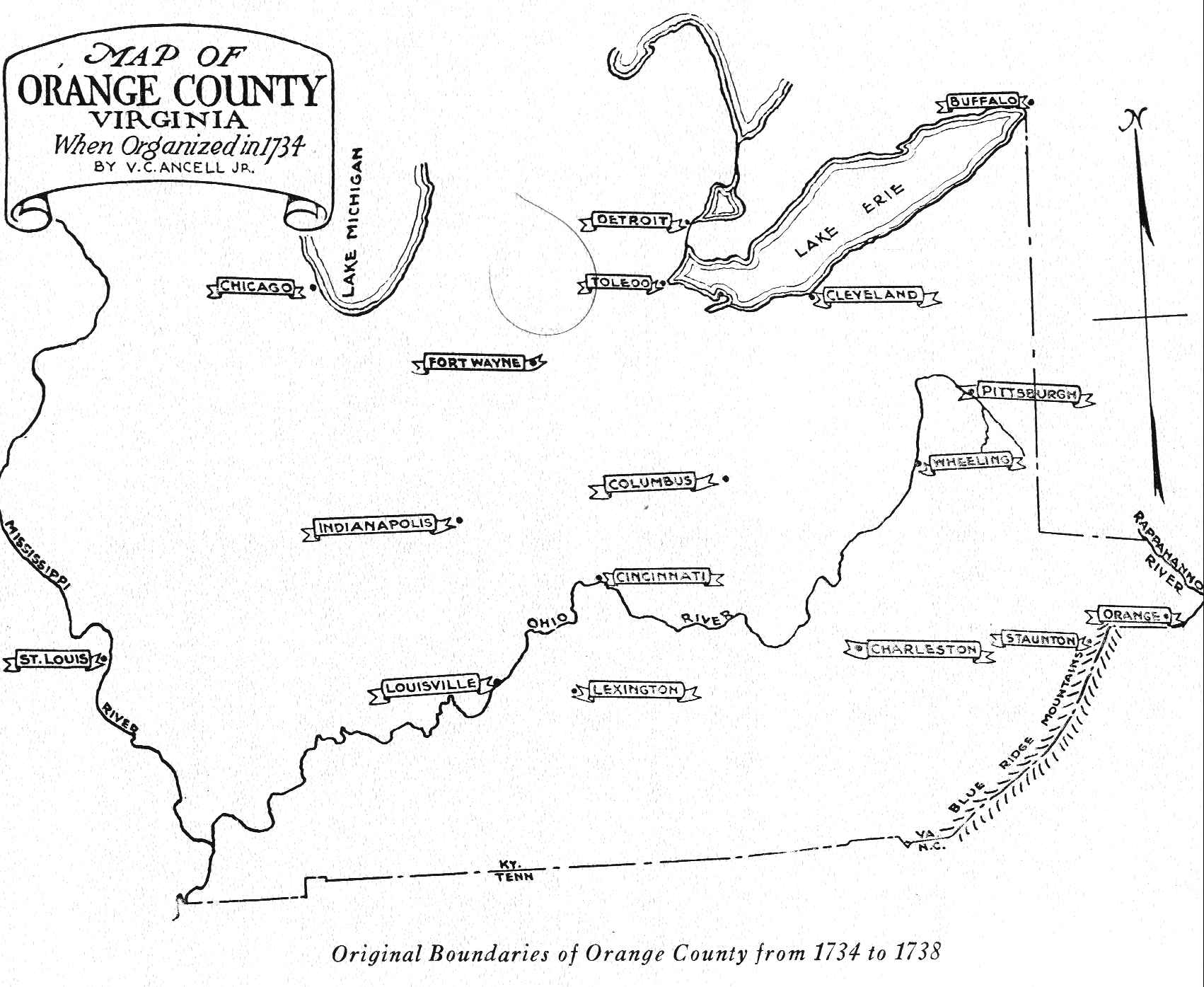
ORANGE COUNTY is exceedingly rich in history. It was named in honor of William of Orange, King of England. It has the unique distinction, according to reliable historians, of being the largest county ever formed. Originally it extended from Germany on the Rapidan River to the Great Lakes and back as far as the Pacific Ocean. The claim to this vast area was the result of the aggressiveness of Governor Alexander Spotswood, who was probably the greatest imperialist ever sent to Virginia by the English government. When he took charge of the colony, in 1710, he rearranged Indian affairs so as to permit exploration and settlement of white men farther west than had been possible up to that time.

In 1722, James Taylor, II, who was a member of that famous party, took up about 15,000 acres of land in the vicinity of Orange, and his settlement grew steadily and progressively. Bloomsbury, the first home in the area of that valiant frontiersman, still stands and may be seen from the present highway leading from Fredericksburg to Orange. It is a beautiful colonial home, well preserved and essentially unchanged.
In passing, it may he of interest to say that James Taylor, II, was the founder of a line of descendant, as numerous and as distinguished as any other line in American history. Within a period of three or four generations, two members of his offspring, namely, James Madison and Zachary Taylor, had served the United States in the highest office within the gift of the electorate.

This is all that remains of Alexander Spotswood's home at Germanna. It Was here at Germanna that Governor Spotswood in 1716 gathered his Knights on the famous expedition to explore the West.
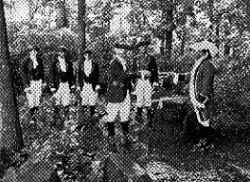
Harrison Spotswood, great grandson of Alexander Spotswood, presenting a Golden Horseshoe to his Knights. This scene will he symbolized in the Pageant during the Bicentennial.
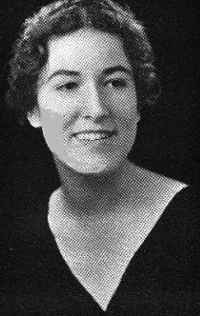
Miss Wycliff Scott who was appointed "Miss Orange County" for the Orange County Bicentennial. Miss Scott is a direct descendant of John Scott.

D. N. Davidson Historian of the Orange County Bicentennial standing under the famous Oaks under which Parson John Leland and James Madison met to formulate the Principles of Religious Freedom as written in The Constitution of the United States.
In making new adjustments after the Revolutionary War, in which citizens of Orange County took an active and conspicuous part, and in drafting political policies and governmental documents, local, state and national, Orange County leaders stood in the forefront. The Virginia Bill of Rights and the United Mates Constitution were influenced very definitely by statesmen from Orange County. The first ten amendments to the Constitution, which grew out of demands of dissenting religious and other groups, led quite lamely by Parson John Leland, who fought for the insertion of the principle of freedom into the actual document of the Constitution, were submitted to The Congress by James Madison, who had drafted the Constitution some years before.
The War of 1812 offered another splendid opportunity to Orange County talent. At that time, James Madison was President of the United States, and James Barbour, his neighbor, was Governor of Virginia. These two most worthy sons of Orange County put their heads together, and won lasting recognition for their public service.
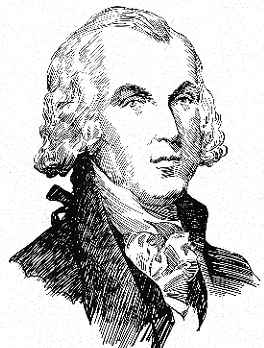
James Madison, 1751-1836, President of The United States. Spent his life at the Madison ancestral home, Montpelier, in Orange County.
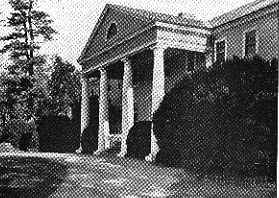
Montpelier, ancestral home of the Madisons, built by James Madison, Sr. Montpelier is xell preserved and is considered a gem of Colonial Architecture. It is owned by Mrs. Thomas Somerville, of Orange, Virginia.
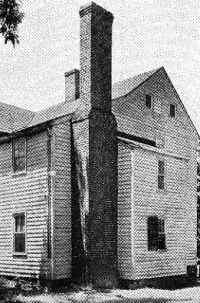
Chestnut Hill Tavern, former home of Dr. Uriel Terrill, a famous son of Orange County. This building was used us a Tavern during the Jackson period. The present owner is Mr. W. A. Nixon, of Orange, Virginia.
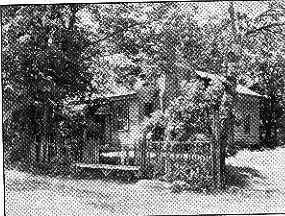
Robinson's Tavern at Locust Grove, Virginia. Built about 1815 and used as a tavern in Stage Coach days. Stands on the site of Old Fredericksburg Swift Run Gap Turnpike, now Route Twenty. It belongs to Mr. Walter Almond of Locust Grove.
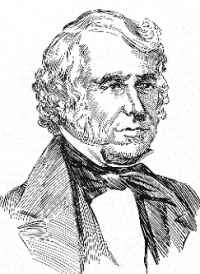
Zachary Taylor, 1784-1850 Mexican War Hero and President of the United States. Born in Orange County.

St. Thomas' Episcopal Church at Orange, Virginia. Built in 1833 and was General Lee's Church during 1862-64

Bloomsbury, the home of James Taylor, II, member of The Knights of The Golden Horseshoe, Pioneer Settler and Great-grandfather of Presidents Madison and Zachary Taylor. Now owned by ,Misses Jerdone, of Orange, Virginia.
Orange County got through the reconstruction period in a very satisfactory manner, and from the seventies to the present time the county has made constructive advances. The county agricultural achievement has been noticeable; free schools have moved forward in a progessive way; a fine system of roads has been well constructed, and new industries have from time to time been established in the county.
Altogether, the people of Orange County remain a homogeneous group. Many of them are direct descendants of the first settlers, and possess the qualities of progress, sturdiness, thrift and integrity characteristic of their forebears. They have long been noted for their hospitality and social charm, and are worthy of their illustrious heritage.